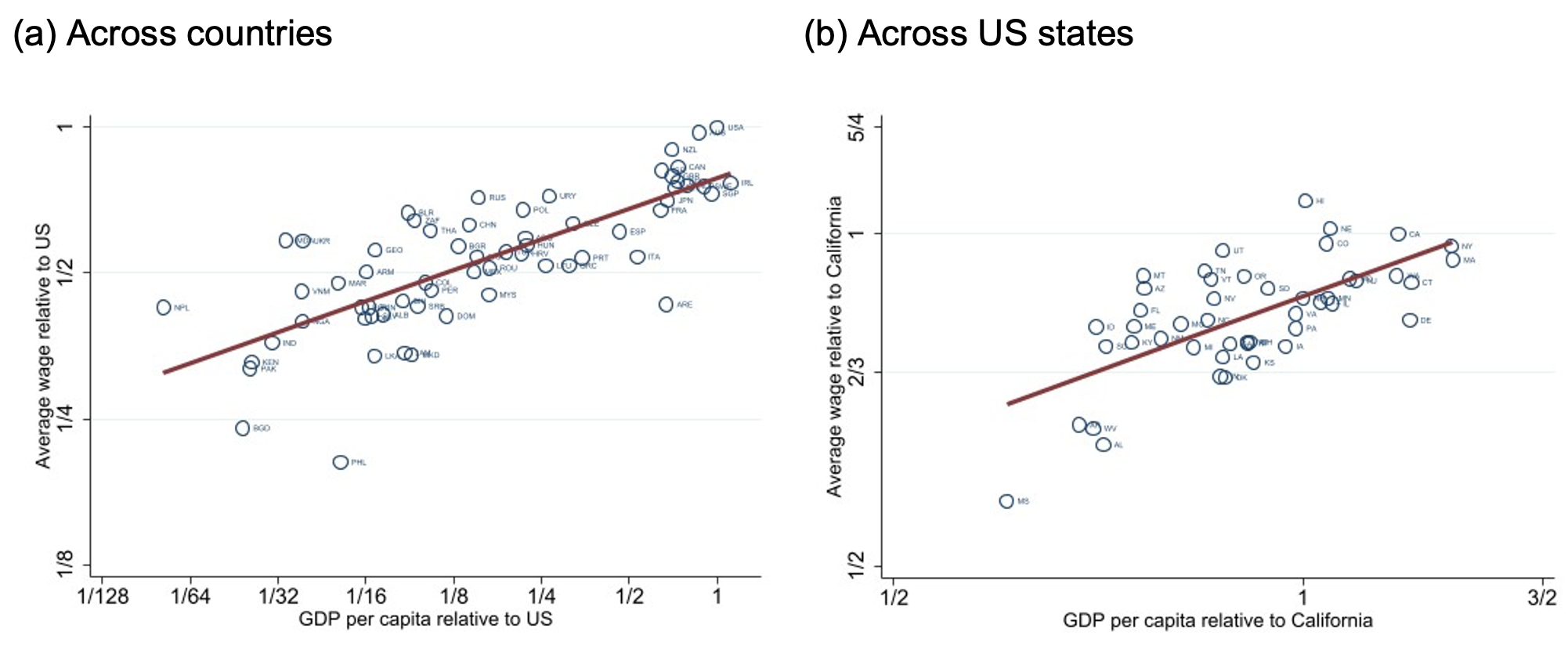The COVID-19 pandemic has dramatically accelerated the trend toward remote work. A growing number of US companies are shifting to a flexible work-from-anywhere model. In a survey by PWC, 28% of employers responded that they plan to allow remote work in another country. These tectonic shifts in the nature of the workplace are likely to have a profound impact on workers in the US and the world (Baldwin 2019, Baldwin and Forslid 2020). Will remote wages converge across countries and regions? Are remote wages more sensitive to international shocks than non-remote wages? Which remote jobs are more likely to be offshored?
In a recent paper (Brinatti et al. 2021), we bring to bear novel data from a large web-based job platform to shed light on these questions. Web-based job platforms match employers and workers located around the world to trade tasks that are delivered online, providing a window into a globalised market for remote work. Such platforms are becoming increasingly popular; their number has tripled over the past decade. By 2020, hundreds of web-based job platforms facilitated millions of international transactions totalling over $50 billion (ILO 2021).
We use a new dataset collected online from one of the largest web-based job platforms in the market today. In the platform, workers are located around the world and compete for the same jobs, which can be done remotely. The jobs require little capital other than a computer or mobile phone, and encompass a wide range of occupations, from accountants to web developers. This makes the platform the ideal marketplace for studying the international price of remote work.
Differences in remote wages across locations
Despite the global nature of the marketplace, remote wages systematically vary across workers who are located in different places. Figure 1 plots average wages across locations. The figure shows large gaps in wages across remote workers located in different countries and across remote workers located in different US states. For example, panel (a) shows that remote wages of Indian workers are on average a third of those of US workers. In fact, remote wages are strongly correlated with GDP per capita: a 1% higher GDP per capita in the worker’s location is associated with 0.2% higher wages, both across countries and US states.
Figure 1 Remote wages and income per capita across locations
Notes: The x-axes report the (log of) the relative GDP per capita in US dollars, taken from the World Development Indicators in panel (a) and the BEA in panel (b). The y-axes plot the average remote wage in each country relative to the US (panel a) or each US state relative to California (panel b).
We show that this relationship is not accounted for by observable differences in workers’ and jobs’ characteristics, nor by differences in the employers’ locations, and that the country of the workers accounts for over a third of the dispersion of wages in the data – more than twice the dispersion accounted for by the combination of all other observable worker, employer, and job characteristics. These results suggest that remote wages are partly determined by the conditions that workers face in their local labour markets, as proxied by the income per capita in the location.
Remote wages and foreign competition
Past waves of globalisation exposed workers to foreign competition through international trade (Goldberg and Pavcnik 2007, Autor et al. 2013, 2016), offshoring (Feenstra and Hanson 2003, Hummels et al. 2011), or international migration (Borjas 2014, Card and Peri 2016). Our paper sheds light on how the current wave of integration due to the emergence of remote work may affect labour markets. Remote workers can be located in different countries, which means they can be exposed to international shocks that affect their foreign competitors.
Building on standard models of exchange-rate pass-through (see the references in Burstein and Gopinath 2015), we estimate how much a worker’s wage denominated in dollars responds to a change in the worker’s dollar opportunity cost of working in the platform (proxied by the inflation and the change in the exchange rate in the worker’s country), and to a change in the average wage of a worker’s competitors. To overcome endogeneity issues, we use an instrumental variables approach, and instrument changes in competitors’ wages with the inflation and the exchange-rate changes in the competitors’ countries.
Our analysis reveals that when the dollar exchange rate increases 1% (a depreciation of the local currency), a worker’s dollar wage declines by roughly 0.2%. This implies that the exchange-rate pass-through to wages in local currency is 80%, so that remote wages expressed in local currency move almost one-to-one with the dollar exchange rate. We also show that a worker’s wage reacts strongly to changes in the wages of other workers on the platform. Since workers are located in different countries, this means that a worker is exposed to international shocks that affect their foreign competitors.
Which remote jobs are easier to offshore?
Finally, we use our data to shed light on which types of jobs or occupations are more likely to be offshored in the future. Existing measures typically hinge on subjective judgements on the different attributes of a job, often made on the basis of whether a job can be done remotely. For example, Blinder and Krueger (2013) establish that a job is easy to offshore if it involves extensive use of computers/email, data entry, talking on the telephone, or analysing data. Our data contain information on the location of both the worker and the employer for each job. We can thus measure the degree of offshorability of a job based on the frequency with which US employers assign contracts to foreign workers in an occupation.
Table 1 reports, for selected occupations, the share of US contracts in which the worker is located outside the US. It shows that whether a job can be performed remotely is an imperfect proxy of the likelihood that the job is offshored. For example, only 30% of grant writer jobs are offshored in our data, even though all of them are performed remotely. In fact, there is substantial heterogeneity in the degree of offshorability across remote jobs: interior design jobs are three times more likely to be offshored than grant writers’ jobs. We also find that wages are less dispersed in occupations that are more easily offshored, providing evidence that offshorability can play a role in equalising wages across remote workers.
Table 1 Most and least offshorable remote occupations
Notes: ‘Share offshored’ refers to the share of US contracts in which the worker is located outside the US.
Concluding remarks
Our findings have profound implications for how the rise of remote work may impact wages across the world. First, remote wages are more equalised than local wages across countries, but the wage gaps across locations are still large. Second, there is a high pass-through from the exchange rate to local-currency remote wages in countries other than the US. These two facts are strikingly similar to findings obtained in the literature that looks at tradable goods prices, suggesting that remote work can potentially integrate service markets in similar ways that trade has tended to globalise goods markets. Finally, our offshorability measure highlights the fact that whether a job is performed remotely is an imperfect proxy for whether a job can be easily offshored. Future work on how to measure offshorability should take this distinction into account.
References
Autor, D H, D Dorn and G H Hanson (2013), “The China syndrome: Local labor market effects of import competition in the US”, American Economic Review 103(6): 2121–68.
Autor, D H, D Dorn and G H Hanson (2016), “The China shock: Learning from labor market adjustment to large changes in trade”, Annual Review of Economics 8: 205–40.
Baldwin, R (2019), The globotics upheaval: Globalization, robotics, and the future of work, Oxford University Press.
Baldwin, R, and R Forslid (2020), “Covid-19, globotics, and development”, VoxEU.org, 16 July.
Blinder, A S, and A B Krueger (2013), “Alternative measures of offshorability: A survey approach”, Journal of Labor Economics 31(S1): 97–128.
Borjas, G J (2014), Immigration economics, Harvard University Press.
Brinatti, A, A Cavallo, J Cravino and A Drenik (2021), “The international price of remote work”, NBER Working Paper 29437.
Burstein, A T, and G Gopinath (2015), “International prices and exchange rates”, in K Rogoff, E Helpman and G Gopinath (eds.), Handbook of International Economics, Vol. 4, Elsevier.
Card, D, and G Peri (2016), “Immigration economics by George J. Borjas: A review essay”, Journal of Economic Literature 54(4): 1333–49.
Feenstra, R C, and G H Hanson (2003), “Global production sharing and rising inequality: A survey of trade and wages”, in Handbook of International Trade, John Wiley and Sons.
Goldberg, P K, and N Pavcnik (2007), “Distributional effects of globalization in developing countries”, Journal of Economic Literature 45(1): 39–82.
Hummels, D, R Jørgensen, J Munch and C Xiang (2011), “Offshoring, inequality, and the value of college degrees”, VoxEU.org, 10 December.
International Labour Organization (ILO) (2021), World employment and social outlook 2021: The role of digital labour platforms in transforming the world of work.









